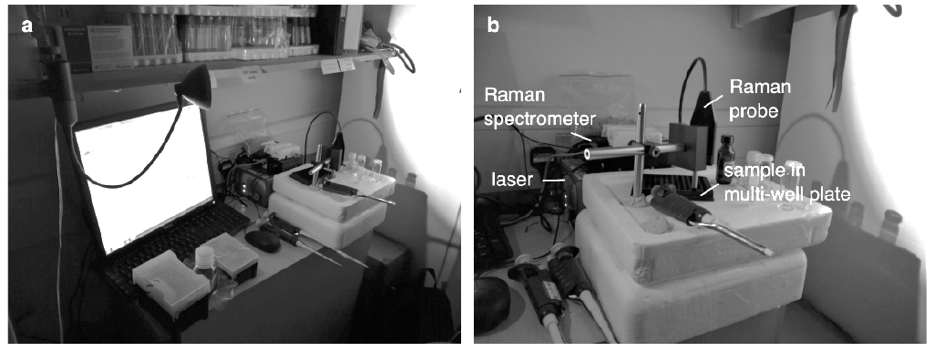Raman spectroscopy is a spectroscopic technique used to observe vibrational, rotational, and other low-frequency modes from molecules. It relies on inelastic scattering, or Raman scattering, of laser light. The laser light interacts with molecular vibrations, phonons or other excitations in the system, and the returned/scattered signal thus has a different frequency than that of the laser. The shift in energy gives information about the vibrational modes in the system. Infrared spectroscopy yields similar but complementary information.
- Model: Home built
- Specifications:
- HeNe laser: 785nm, class 3B (350mW power, but ~40mW output power comes out of the probe) model I0785ML0350MF;
- Raman probe;
- Ocean Optics spectrometer;
- computer with SpectraSuite software.
- Manufacturer:
- Laser: Innovative Photonic Solutions.
- http://www.ipslasers.com/products-by-wavelength-785-nm.html (see under Multi-mode)
- http://www.ipslasers.com/data-sheets/MM-Fiber-Coupled-M-type-IPS.pdf
- This is a very strong laser, so care should be taken to avoid injury! There are 4 safety mechanisms: plug needs to be switched on, key must be switched to turn on laser, shutter needs to be opened, and there is an emergency button that switches the entire module off.
- Integrated Raman Probe: Innovative Photonic Solutions.
- Spectrometer: Ocean Optics QE65000
- Laser: Innovative Photonic Solutions.
- Location: temporary in the clinic room, John van Geest Centre for Brain Repair (Cambridge)
- Responsible: Marlous Kamp and Charlie Readman for training and info, William Kuan for access to hospital facilites.
- Training Required:
- General or departmental laser safety training from the University
- Instrument training on site by Marlous or Charlie.
- Booking required: We have a booking calendar, only accessible to trained users.
- Usage Costs: It depends on the collaboration and interaction with the Scherman group.

